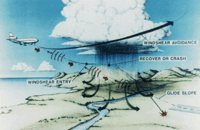Wind shear
[1] Wind shear is a microscale meteorological phenomenon occurring over a very small distance, but it can be associated with mesoscale or synoptic scale weather features such as squall lines and cold fronts.
Strong vertical wind shear within the troposphere also inhibits tropical cyclone development but helps to organize individual thunderstorms into longer life cycles which can then produce severe weather.
[3] Vertical speed changes greater than 4.9 knots (2.5 m/s) also qualify as significant wind shear for aircraft.
[4] The rationale for this additional caution includes:[citation needed] Wind shear is also a key factor in the formation of severe thunderstorms.
Sometimes, there are even directional differences, particularly if local sea breezes change the wind on shore during daylight hours.
[12] The thermal wind equation is where the φ are geopotential height fields with φ1 > φ0, f is the Coriolis parameter, and k is the upward-pointing unit vector in the vertical direction.
Tropical cyclone development requires relatively low values of vertical wind shear so that their warm core can remain above their surface circulation center, thereby promoting intensification.
Strongly sheared tropical cyclones weaken as the upper circulation is blown away from the low-level center.
[citation needed] In gliding, wind gradients just above the surface affect the takeoff and landing phases of the flight of a glider.
If the wind gradient is significant or sudden, or both, and the pilot maintains the same pitch attitude, the indicated airspeed will increase, possibly exceeding the maximum ground launch tow speed.
As the glider descends through the wind gradient on final approach to landing, airspeed decreases while sink rate increases, and there is insufficient time to accelerate prior to ground contact.
It is a particular problem for gliders which have a relatively long wingspan, which exposes them to a greater wind speed difference for a given bank angle.
If the wind encounters distortions in the inversion layer caused by thermals coming up from below, it will produce significant shear waves that can be used for soaring.
Sudden changes in wind velocity can cause rapid decreases in airspeed, leading to the aircraft being unable to maintain altitude.
Following the 1985 crash of Delta Air Lines Flight 191, in 1988 the U.S. Federal Aviation Administration mandated that all commercial aircraft have airborne wind shear detection and alert systems by 1993.
The installation of high-resolution Terminal Doppler Weather Radar stations at many U.S. airports that are commonly affected by windshear has further aided the ability of pilots and ground controllers to avoid wind shear conditions.
Sailors may also adjust the trim of the sail to account for low-level wind shear, for example using a boom vang.
[25] Wind shear can have a pronounced effect upon sound propagation in the lower atmosphere, where waves can be "bent" by refraction phenomenon.
[32] This low-level wind shear can cause a large bending moment in the shaft of a two-bladed turbine when the blades are vertical.








